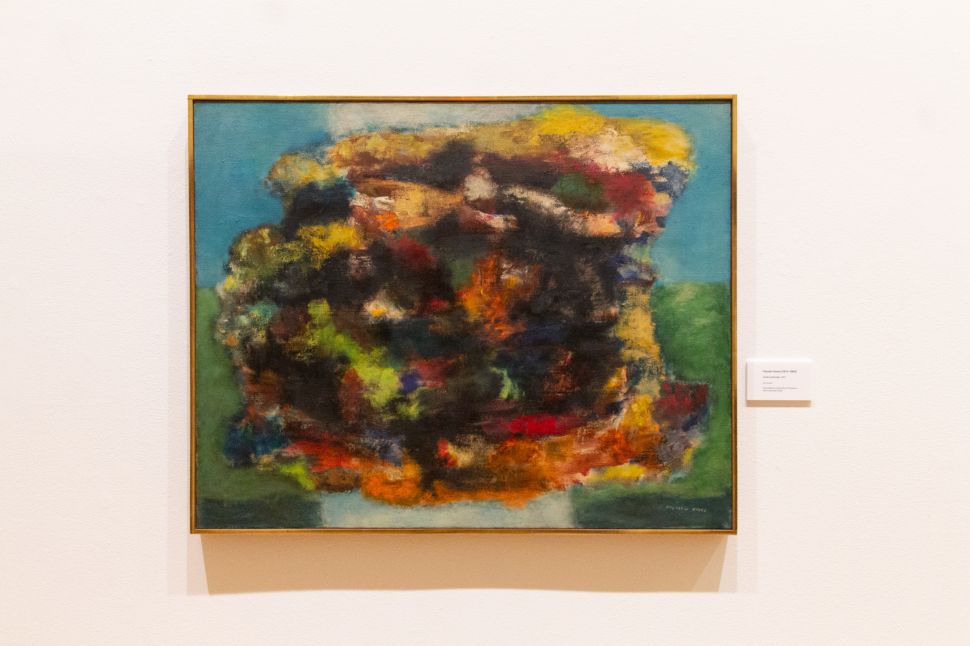In 1998, Jack Whitten wrote in his personal journals thirty-two objectives for his studio practice, among them were “6. the painting is not an illustration of anything.” and “8. allow the paint as material to take care of the black thing.” These musings, though initially intended to inform only Whitten’s own practice, have come to serve as touchstones for countless others. They also accurately describe the exhibition “Innervisions” at the Clark Atlanta University Art Museum.
Whitten, although not included in the exhibition, is a fitting place to start when considering an exhibition that presents Black abstract painters beginning with the rise of Abstract Expressionism in the 1950s. That movement represents an art historical milestone: the first art movement to originate solely from the United States. Unsurprisingly, Abstract Expressionism, like most canonical art historical movements, was largely practiced by white men of means who were continuing the work of other Modernist movements, like Surrealism and Suprematism, and exploring the “purely” aesthetic qualities of art and their ability to document the unconscious mind. Whitten and other Black artists like him, such as Howardena Pindell and Sam Gilliam, were responding to something different.
SEE ALSO: Shana Hoehn Explores the Uncanny Dichotomy Between Suffocation and Shelter in L.A.
Social Realism, a movement equal parts artistic and labor-related from the 1930s and 1940s, sought to document and uplift the working class—a response to the horrors of the First World War. As much of the working class and many of those who died in the war were people of color, so too were the art movement’s practitioners. While Social Realism produced art stars like Elizabeth Catlett and Faith Ringgold, its restriction of identity as a subject became suffocating for artists like Whitten, which inspired them to abandon recognizable imagery completely and explore non-objective abstraction. It is from this moment onward that is presented in “Innervisions.”
Felrath Hines is represented with Aerial Landscape (1957), a cloud of brownish blacks, ochres, ruddy reds and verdant greens floating against two brush-textured bands of green and blue—evoking a landscape with a nebulous, bodiless entity. Joe Overstreet is here with Untitled (1957), an irregularly stitched canvas artwork. Two triangles and a trapezoid are conjoined and painted with thin washes of vibrant orange, warm purple and emerald—a juxtaposition of free-flowing paint washes and rigid geometric shapes. David Hammons is seen, or rather not seen, in On Loan (1999), a picture hanger inside a faint rectangle of dust applied directly to the museum wall. Where has this artwork gone that would cause it to leave its well-worn place? Most magnificently, Sam Gilliam is represented with Untitled (1971), a free-hanging cotton duck painting. Suspended in the gallery from two rings of rope that cause the cotton to swing between the two, the surface is mottled with flecks and washes of ultramarine, carmine, honey and teal.
These explorations of abstraction persisted, as seen with Whitten’s journal entry, well into the 1990s and 2000s, and many artists who work in this way are still powerful players in the contemporary art world—which is to say, Black abstraction in the United States has far outlived its overshadowing sibling, Abstract Expressionism. The power of this exhibition lies in rejection—both its focus on the ways that Black abstractionists rejected the limitations of Social Realism and the rejection of Jackson Pollock and his ilk as the sole originators of the first all-American art movement. “Innervisions” shows Black artists exhibiting just as much range as their more widely lauded white counterparts and that their practices have more staying power.
Further, Clark Atlanta University Art Museum contests a widespread understanding of art history with a single question: If these artists have been working in this way for seventy years, why have they not been adopted into the art historical canon? It is clearly time for a reevaluation—one that clears space for the adoption of Black abstraction as a twin movement to Abstract Expressionism. After all, what could be more all-American than self-determination?
“Innervisions” is at the Clark Atlanta University Art Museum through May 2.

